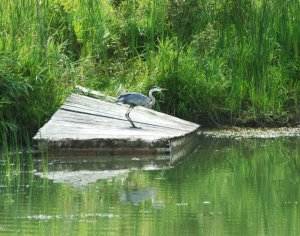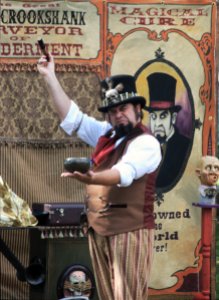by Paul Smith

The Rideau Canal includes several very different sections – most of which can only be described as idyllic. For every section, there must be a transition, and Smiths Falls had to be the most sudden, even surrealistic, transition we saw. We had been cruising along through areas with the channel meandering through open farmlands ever since Merrickville. All of the locks, and many of the nearby buildings, had been the original stonework laid by the French Canadian and Irish immigrant workers almost 200 years ago – an open air museum. Other than us, the only sounds were the wildlife around us – loudest of which were the screeches of the Osprey and croaking call of the Great Blue Herons.

Arriving at Smiths Falls, we cleared the first lock – all as expected – beautiful! Then we arrived at the second Smiths Falls flight, three locks, and something looked funny – there were potted plants sitting on the lock sills! Hmmm…Something’s up! A slight turn to the right and we were greeted by a modern concrete lock and bridge, both presided over by a brightly painted water tower. The lock was even hydraulically operated instead of hand cranked vales and gates. Okay, welcome back to the modern world…

We cleared the lock, which opened up on to a large pool, and were surrounded by modern concrete walls, a campground for RV’s, and a park full of people, booths, and tents. There was a large festival in town and we were to be front and center! We were greeted by a very friendly and eclectic collection of folks including kids on skateboards, “Steampunk” ladies, and a local church group offering coffee and water. There was even live music playing on a stage further in the park!
After we settled in and set up for the expected crowds in the morning, we were able to do a little exploring of Smiths Falls. What we found was a town that was also in transition. Most of the downtown could be described as a 19th century mill town, a continuation of the open air museum. Clearly, the Rideau and the railroad had had a large hand in defining this town’s past. However, there were other areas, most obviously for us the waterfront, the park, and the water tower which had been recently freshened up with a modern paint job and powerful lighting at night, that demonstrated that Smiths Falls is on its way back! Bridging the two eras was the Rideau Canal Museum, built in a former mill and yet using modern museum technologies to remind visitors of the huge and technically impressive efforts used to build the waterway.
After the day open to the public, a public that came out in impressive numbers and expressed their gratitude for our visit with lots of interest and questions, we headed off through the last lock at Smiths Falls – back to 1832.

This parting had a sad moment to it as we had to say good bye to Isaac Parker, our personable, energetic, and thoroughly enjoyable high school student volunteer. He had been on the schooner since she left Burlington and endeared himself to everybody. A great experience on all sides, one I am sure he will never forget.
Special Thanks to:
Paul Smith
An engineer at NRG Systems in Hinesburg, Paul has been a long time volunteer with the schooner project. While spending time on boats is a passion, he also devotes time to exploring the options in the renewable energy fields – most recently by building his own electric scooter.

Pingback: The Rideau Canal to Jones Falls, Kingston and Sackets Harbor | Lake Champlain Maritime Museum
Pingback: Captain’s Log, Part 5 | Lake Champlain Maritime Museum
Pingback: The Rideau Canal to Jones Falls, Kingston and Sackets Harbor
Pingback: Lois McClure Captain’s Log, Part 5
Pingback: 'Lois McClure': Captain’s Log, Part 5